2023 HYUNDAI SANTA FE HYBRID display
[x] Cancel search: displayPage 522 of 623
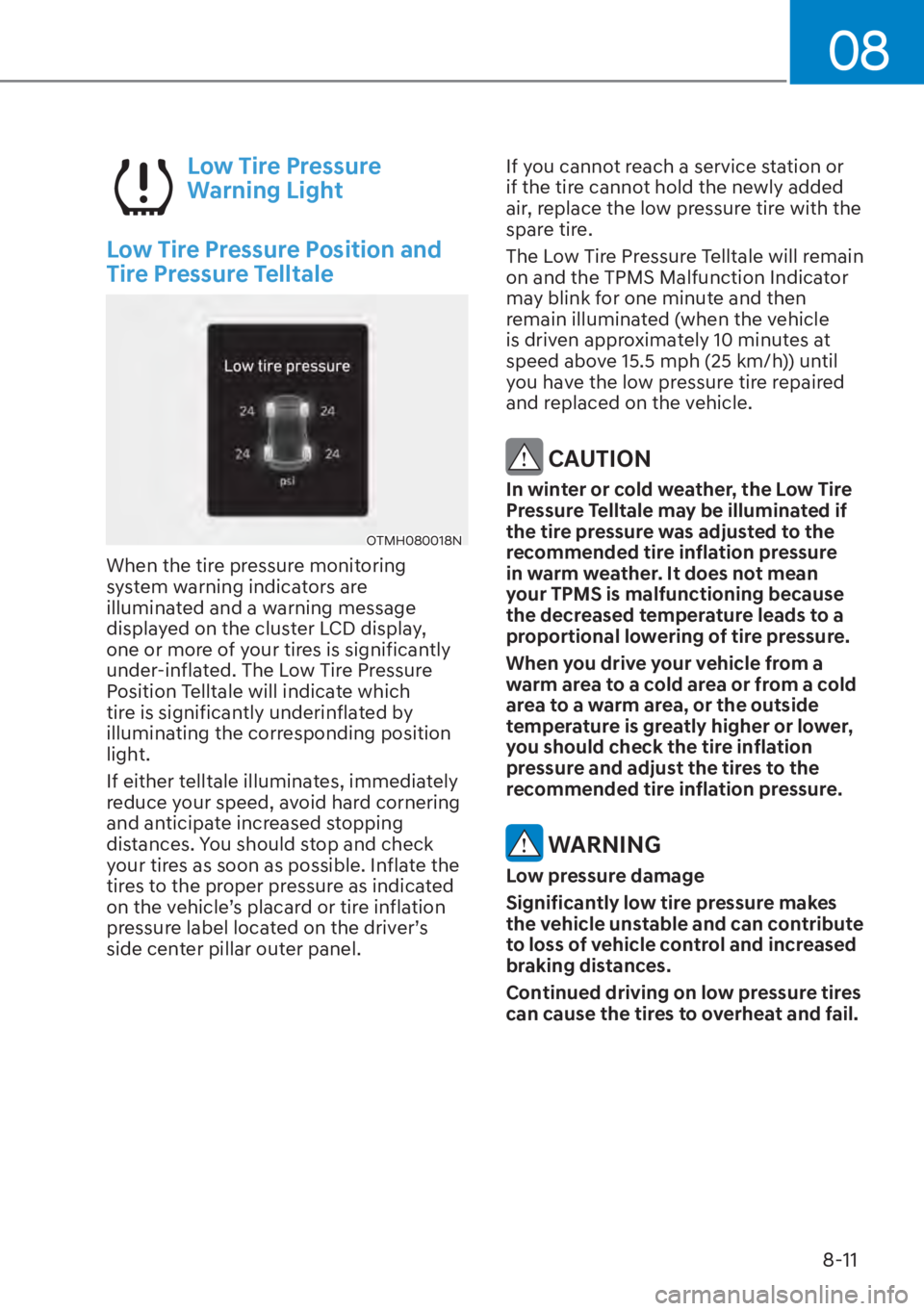
08
8-11
Low Tire Pressure
Warning Light
Low Tire Pressure Position and
Tire Pressure Telltale
OTMH080018N
When the tire pressure monitoring
system warning indicators are
illuminated and a warning message
displayed on the cluster LCD display,
one or more of your tires is significantly
under-inflated. The Low Tire Pressure
Position Telltale will indicate which
tire is significantly underinflated by
illuminating the corresponding position
light.
If either telltale illuminates, immediately
reduce your speed, avoid hard cornering
and anticipate increased stopping
distances. You should stop and check
your tires as soon as possible. Inflate the
tires to the proper pressure as indicated
on the vehicle’s placard or tire inflation
pressure label located on the driver’s
side center pillar outer panel. If you cannot reach a service station or
if the tire cannot hold the newly added
air, replace the low pressure tire with the
spare tire.
The Low Tire Pressure Telltale will remain
on and the TPMS Malfunction Indicator
may blink for one minute and then
remain illuminated (when the vehicle
is driven approximately 10 minutes at
speed above 15.5 mph (25 km/h)) until
you have the low pressure tire repaired
and replaced on the vehicle.
CAUTION
In winter or cold weather, the Low Tire
Pressure Telltale may be illuminated if
the tire pressure was adjusted to the
recommended tire inflation pressure
in warm weather. It does not mean
your TPMS is malfunctioning because
the decreased temperature leads to a
proportional lowering of tire pressure.
When you drive your vehicle from a
warm area to a cold area or from a cold
area to a warm area, or the outside
temperature is greatly higher or lower,
you should check the tire inflation
pressure and adjust the tires to the
recommended tire inflation pressure.
WARNING
Low pressure damage
Significantly low tire pressure makes
the vehicle unstable and can contribute
to loss of vehicle control and increased
braking distances.
Continued driving on low pressure tires
can cause the tires to overheat and fail.
Page 523 of 623
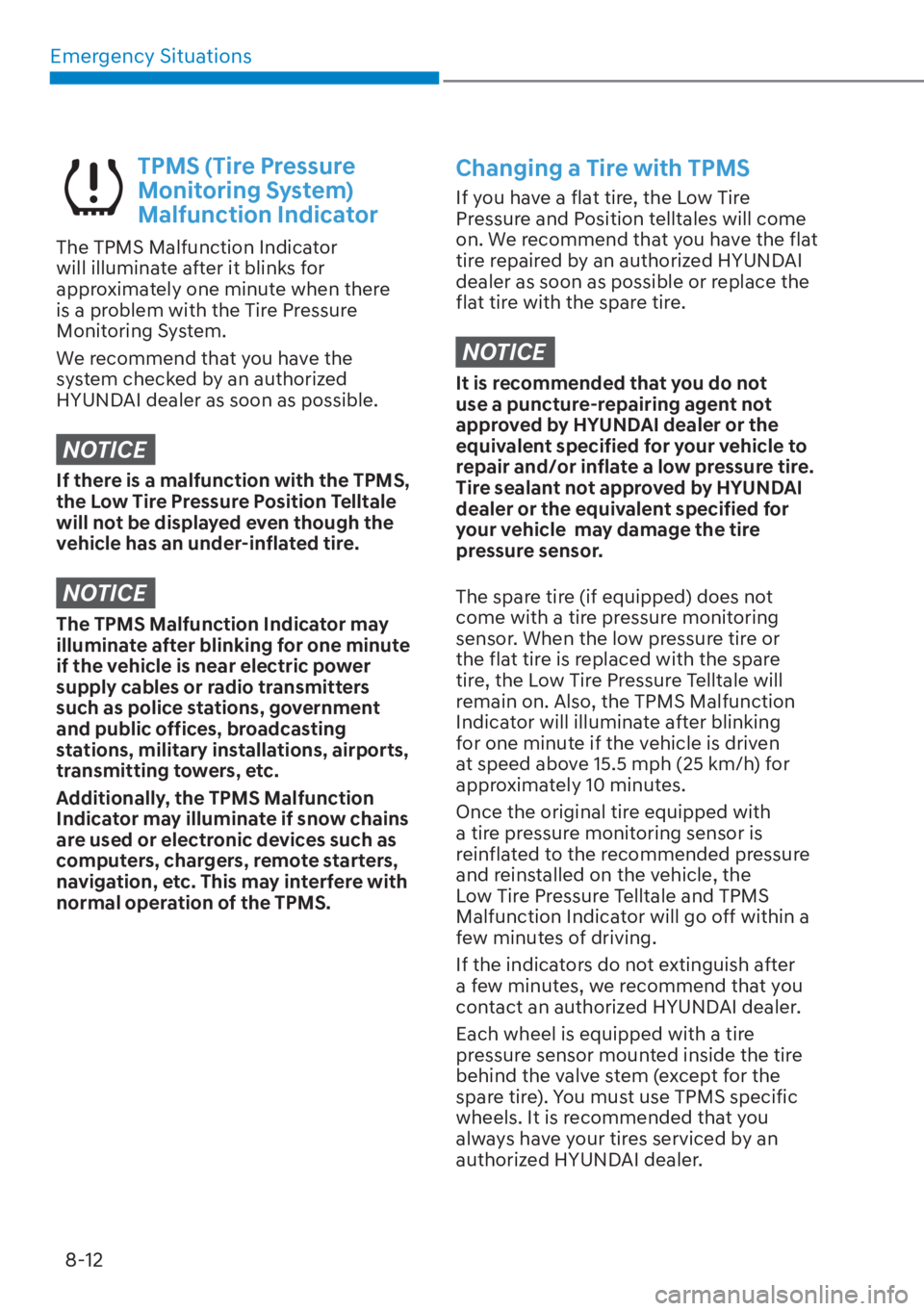
Emergency Situations8-12
TPMS (Tire Pressure
Monitoring System)
Malfunction Indicator
The TPMS Malfunction Indicator
will illuminate after it blinks for
approximately one minute when there
is a problem with the Tire Pressure
Monitoring System.
We recommend that you have the
system checked by an authorized
HYUNDAI dealer as soon as possible.
NOTICE
If there is a malfunction with the TPMS,
the Low Tire Pressure Position Telltale
will not be displayed even though the
vehicle has an under-inflated tire.
NOTICE
The TPMS Malfunction Indicator may
illuminate after blinking for one minute
if the vehicle is near electric power
supply cables or radio transmitters
such as police stations, government
and public offices, broadcasting
stations, military installations, airports,
transmitting towers, etc.
Additionally, the TPMS Malfunction
Indicator may illuminate if snow chains
are used or electronic devices such as
computers, chargers, remote starters,
navigation, etc. This may interfere with
normal operation of the TPMS.
Changing a Tire with TPMS
If you have a flat tire, the Low Tire
Pressure and Position telltales will come
on. We recommend that you have the flat
tire repaired by an authorized HYUNDAI
dealer as soon as possible or replace the
flat tire with the spare tire.
NOTICE
It is recommended that you do not
use a puncture-repairing agent not
approved by HYUNDAI dealer or the
equivalent specified for your vehicle to
repair and/or inflate a low pressure tire.
Tire sealant not approved by HYUNDAI
dealer or the equivalent specified for
your vehicle may damage the tire
pressure sensor.
The spare tire (if equipped) does not
come with a tire pressure monitoring
sensor. When the low pressure tire or
the flat tire is replaced with the spare
tire, the Low Tire Pressure Telltale will
remain on. Also, the TPMS Malfunction
Indicator will illuminate after blinking
for one minute if the vehicle is driven
at speed above 15.5 mph (25 km/h) for
approximately 10 minutes.
Once the original tire equipped with
a tire pressure monitoring sensor is
reinflated to the recommended pressure
and reinstalled on the vehicle, the
Low Tire Pressure Telltale and TPMS
Malfunction Indicator will go off within a
few minutes of driving.
If the indicators do not extinguish after
a few minutes, we recommend that you
contact an authorized HYUNDAI dealer.
Each wheel is equipped with a tire
pressure sensor mounted inside the tire
behind the valve stem (except for the
spare tire). You must use TPMS specific
wheels. It is recommended that you
always have your tires serviced by an
authorized HYUNDAI dealer.
Page 575 of 623
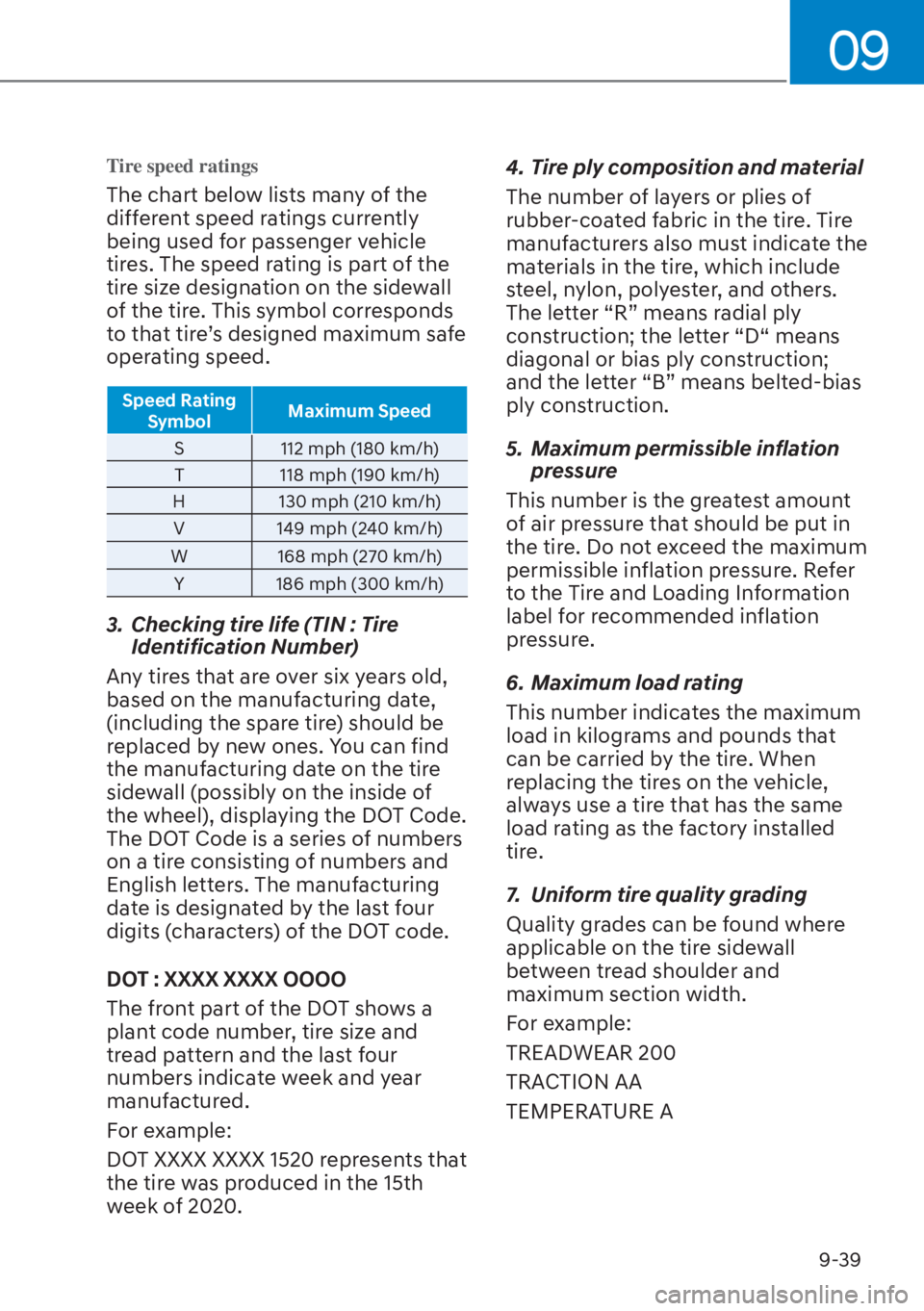
09
9-39
Tire speed ratings
The chart below lists many of the
different speed ratings currently
being used for passenger vehicle
tires. The speed rating is part of the
tire size designation on the sidewall
of the tire. This symbol corresponds
to that tire’s designed maximum safe
operating speed.
Speed Rating Symbol Maximum Speed
S 112 mph (180 km/h)
T
118 mph (190 km/h)
H 130 mph (210 km/h)
V 149 mph (240 km/h)
W 168 mph (270 km/h) Y 186 mph (300 km/h)
3. Checking tire life (TIN : Tire Identification Number)
Any tires that are over six years old,
based on the manufacturing date,
(including the spare tire) should be
replaced by new ones. You can find
the manufacturing date on the tire
sidewall (possibly on the inside of
the wheel), displaying the DOT Code.
The DOT Code is a series of numbers
on a tire consisting of numbers and
English letters. The manufacturing
date is designated by the last four
digits (characters) of the DOT code.
DOT : XXXX XXXX OOOO
The front part of the DOT shows a
plant code number, tire size and
tread pattern and the last four
numbers indicate week and year
manufactured.
For example:
DOT XXXX XXXX 1520 represents that
the tire was produced in the 15th
week of 2020. 4. Tire ply composition and material
The number of layers or plies of
rubber-coated fabric in the tire. Tire
manufacturers also must indicate the
materials in the tire, which include
steel, nylon, polyester, and others.
The letter “R” means radial ply
construction; the letter “D“ means
diagonal or bias ply construction;
and the letter “B” means belted-bias
ply construction.
5. Maximum permissible inflation
pressure
This number is the greatest amount
of air pressure that should be put in
the tire. Do not exceed the maximum
permissible inflation pressure. Refer
to the Tire and Loading Information
label for recommended inflation
pressure.
6. Maximum load rating
This number indicates the maximum
load in kilograms and pounds that
can be carried by the tire. When
replacing the tires on the vehicle,
always use a tire that has the same
load rating as the factory installed
tire.
7. Uniform tire quality grading
Quality grades can be found where
applicable on the tire sidewall
between tread shoulder and
maximum section width.
For example:
TREADWEAR 200
TRACTION AA
TEMPERATURE A
Page 582 of 623
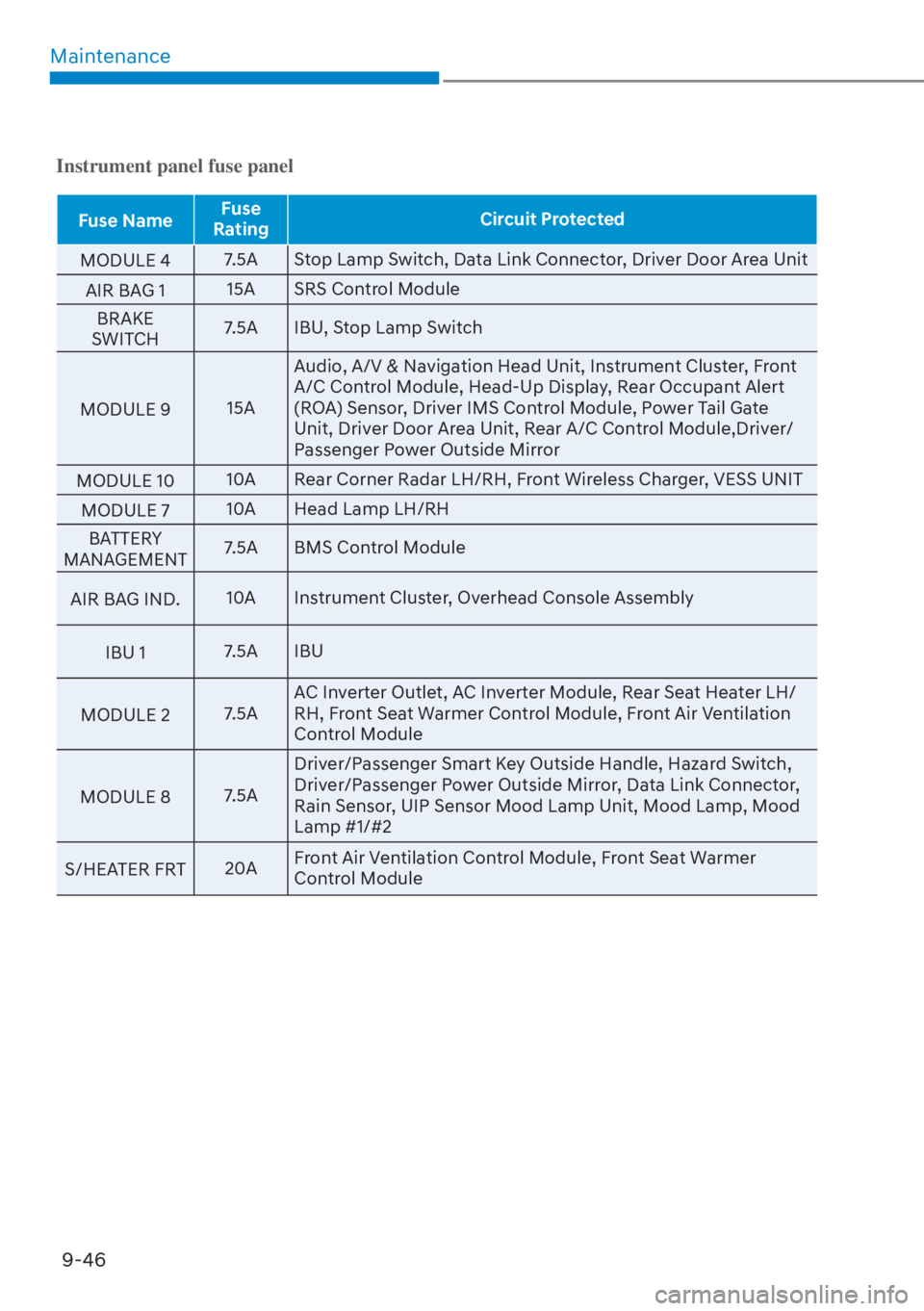
Maintenance9-46
Instrument panel fuse panel
Fuse Name Fuse
Rating Circuit Protected
MODULE 4 7
.5A Stop Lamp Switch, Data Link Connector, Driver Door Area Unit
AIR BAG 1 15A SRS Control Module
BRAKE
SWITCH 7.5A IBU, Stop Lamp Switch
MODULE 9 15AAudio, A/V & Navigation Head Unit, Instrument Cluster, Front
A/C Control Module, Head-Up Display, Rear Occupant Alert
(ROA) Sensor, Driver IMS Control Module, Power Tail Gate
Unit, Driver Door Area Unit, Rear A/C Control Module,Driver/
Passenger Power Outside Mirror
MODULE 10 10A Rear Corner Radar LH/RH, Front Wireless Charger, VESS UNIT
MODULE 7 10A Head Lamp LH/RH
BATTERY
MANAGEMENT7.5A BMS Control Module
AIR BAG IND. 10A Instrument Cluster, Overhead Console Assembly
IBU 1 7.5A IBU
MODULE 2 7.5AAC Inverter Outlet, AC Inverter Module, Rear Seat Heater LH/
RH, Front Seat Warmer Control Module, Front Air Ventilation
Control Module
MODULE 8 7.5ADriver/Passenger Smart Key Outside Handle, Hazard Switch,
Driver/Passenger Power Outside Mirror, Data Link Connector,
Rain Sensor, UIP Sensor Mood Lamp Unit, Mood Lamp, Mood
Lamp #1/#2
S/HEATER FRT 20AFront Air Ventilation Control Module, Front Seat Warmer
Control Module
Page 583 of 623
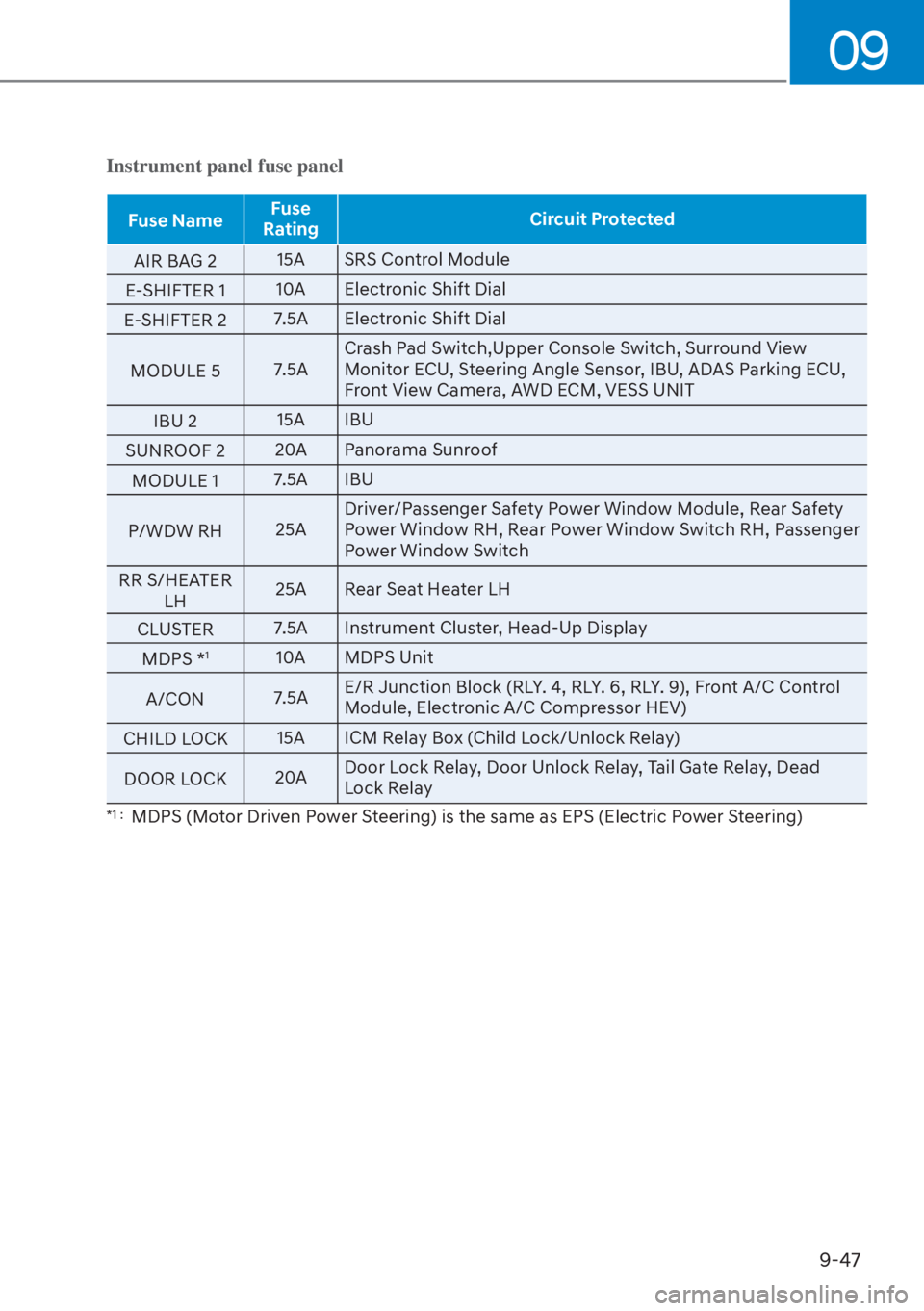
09
9-47
Instrument panel fuse panel
Fuse NameFuse
Rating Circuit Protected
AIR BAG 2 15A
SRS Control Module
E-SHIFTER 1 10A Electronic Shift Dial
E-SHIFTER 2 7.5A Electronic Shift Dial
MODULE 5 7.5ACrash Pad Switch,Upper Console Switch, Surround View
Monitor ECU, Steering Angle Sensor, IBU, ADAS Parking ECU,
Front View Camera, AWD ECM, VESS UNIT
IBU 2 15A IBU
SUNROOF 2 20A Panorama Sunroof
MODULE 1 7.5A IBU
P/WDW RH 25ADriver/Passenger Safety Power Window Module, Rear Safety
Power Window RH, Rear Power Window Switch RH, Passenger
Power Window Switch
RR S/HEATER LH 25A Rear Seat Heater LH
CLUSTER 7.5A Instrument Cluster, Head-Up Display
MDPS *
110A MDPS Unit
A/CON 7.5AE/R Junction Block (RLY. 4, RLY. 6, RLY. 9), Front A/C Control
Module, Electronic A/C Compressor HEV)
CHILD LOCK 15A ICM Relay Box (Child Lock/Unlock Relay)
DOOR LOCK 20ADoor Lock Relay, Door Unlock Relay, Tail Gate Relay, Dead
Lock Relay
*1 : MDPS (Motor Driven Power Steering) is the same as EPS (Electric Power Steering)
Page 611 of 623
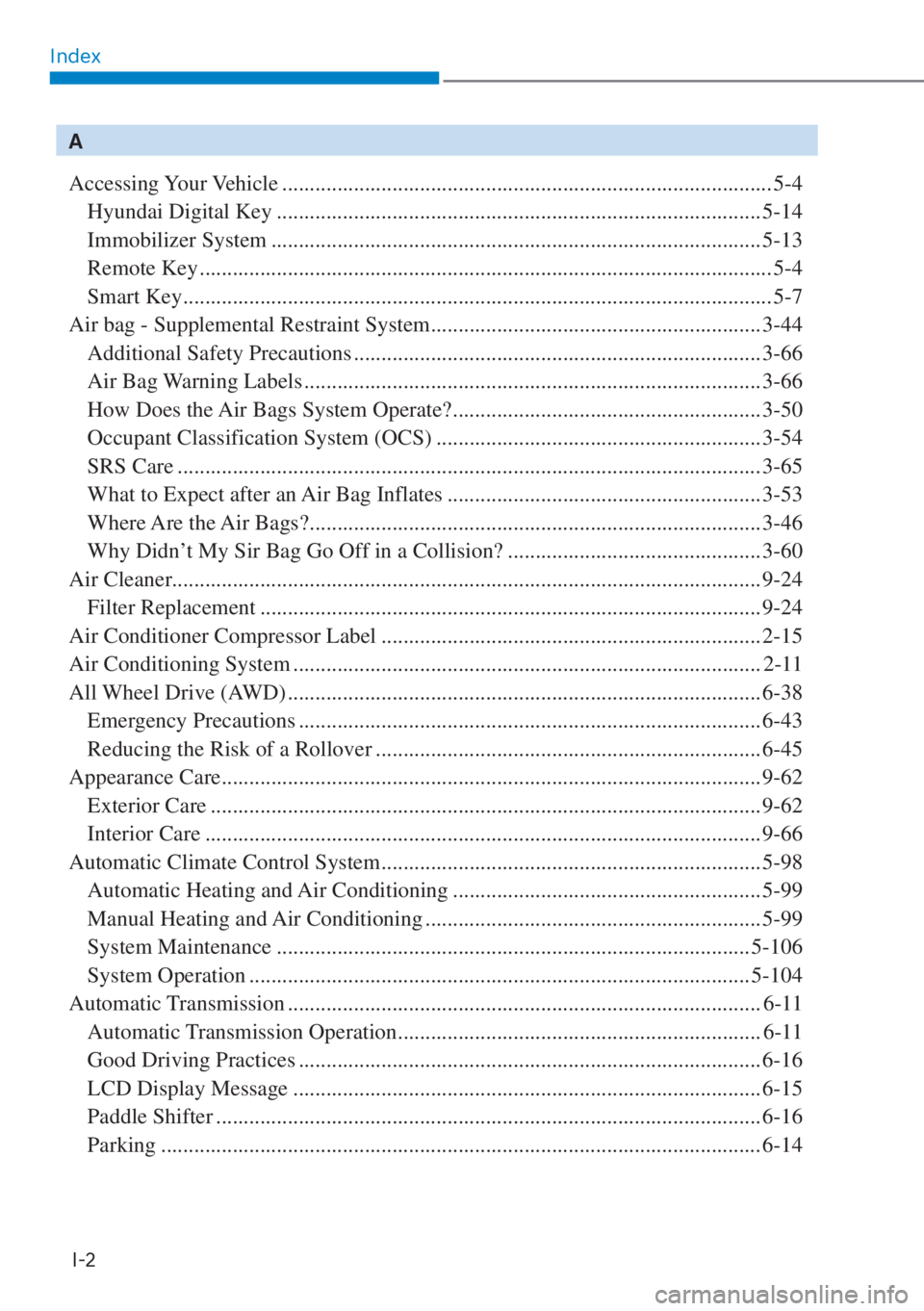
IndexI-2
A
Accessing Your Vehicle ........................................................................\
................. 5-4
Hyundai Digital Key ........................................................................\
................ 5-14
Immobilizer System ........................................................................\
................. 5-13
Remote Key ........................................................................\
................................ 5-4
Smart Key ........................................................................\
................................... 5-7
Air bag - Supplemental Restraint System ............................................................ 3-44
Additional Safety Precautions ........................................................................\
.. 3-66
Air Bag Warning Labels ........................................................................\
........... 3-66
How Does the Air Bags System Operate? ........................................................ 3-50
Occupant Classification System (OCS) ........................................................... 3-54
SRS Care ........................................................................\
.................................. 3-65
What to Expect after an Air Bag Inflates ......................................................... 3-53
Where Are the Air Bags? ........................................................................\
.......... 3-46
Why Didn’t My Sir Bag Go Off in a Collision? .............................................. 3-60
Air Cleaner........................................................................\
................................... 9-24
Filter Replacement ........................................................................\
................... 9-24
Air Conditioner Compressor Label ..................................................................... 2-15
Air Conditioning System ........................................................................\
............. 2-11
All Wheel Drive (AWD) ........................................................................\
.............. 6-38
Emergency Precautions ........................................................................\
............ 6-43
Reducing the Risk of a Rollover ...................................................................... 6-45
Appearance Care ........................................................................\
.......................... 9-62
Exterior Care ........................................................................\
............................ 9-62
Interior Care ........................................................................\
............................. 9-66
Automatic Climate Control System ..................................................................... 5-98
Automatic Heating and Air Conditioning ........................................................ 5-99
Manual Heating and Air Conditioning ............................................................. 5-99
System Maintenance ........................................................................\
.............. 5-106
System Operation ........................................................................\
................... 5-104
Automatic Transmission ........................................................................\
.............. 6-11
Automatic Transmission Operation .................................................................. 6-11
Good Driving Practices ........................................................................\
............ 6-16
LCD Display Message ........................................................................\
............. 6-15
Paddle Shifter ........................................................................\
........................... 6-16
Parking ........................................................................\
..................................... 6-14
Page 614 of 623
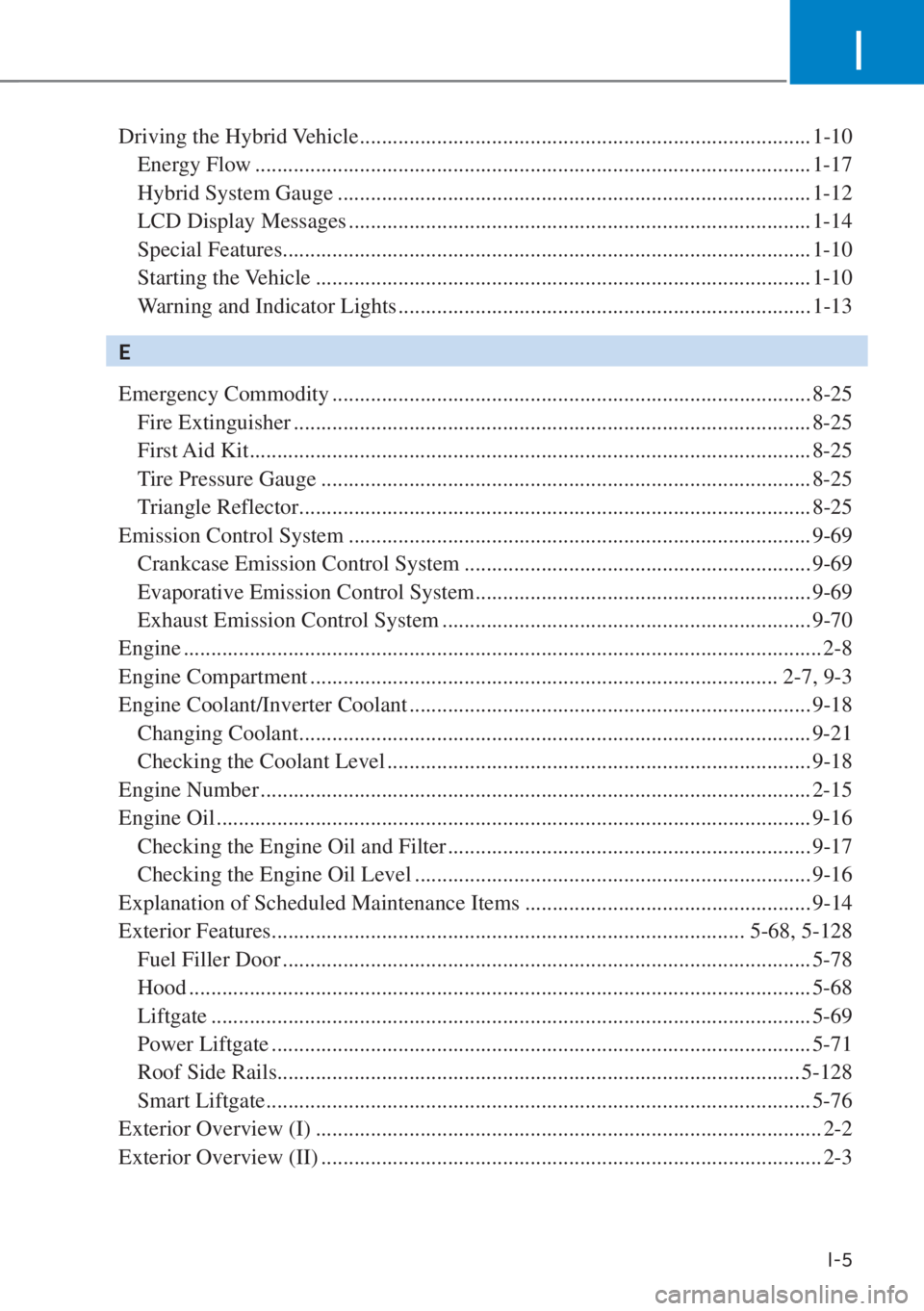
I
I-5
Driving the Hybrid Vehicle ........................................................................\
.......... 1-10
Energy Flow ........................................................................\
............................. 1-17
Hybrid System Gauge ........................................................................\
.............. 1-12
LCD Display Messages ........................................................................\
............ 1-14
Special Features ........................................................................\
........................ 1-10
Starting the Vehicle ........................................................................\
.................. 1-10
Warning and Indicator Lights ........................................................................\
... 1-13
E
Emergency Commodity ........................................................................\
............... 8-25
Fire Extinguisher ........................................................................\
...................... 8-25
First Aid Kit ........................................................................\
.............................. 8-25
Tire Pressure Gauge ........................................................................\
................. 8-25
Triangle Reflector ........................................................................\
..................... 8-25
Emission Control System ........................................................................\
............ 9-69
Crankcase Emission Control System ............................................................... 9-69
Evaporative Emission Control System ............................................................. 9-69
Exhaust Emission Control System ................................................................... 9-70
Engine .................................................................\
................................................... 2-8
Engine Compartment ........................................................................\
............. 2-7, 9-3
Engine Coolant/Inverter Coolant ........................................................................\
. 9-18
Changing Coolant ........................................................................\
..................... 9-21
Checking the Coolant Level ........................................................................\
..... 9-18
Engine Number ........................................................................\
............................ 2-15
Engine Oil ........................................................................\
.................................... 9-16
Checking the Engine Oil and Filter .................................................................. 9-17
Checking the Engine Oil Level ........................................................................\
9-16
Explanation of Scheduled Maintenance Items .................................................... 9-14
Exterior Features ........................................................................\
.............. 5-68, 5-128
Fuel Filler Door ........................................................................\
........................ 5-78
Hood ........................................................................\
......................................... 5-68
Liftgate ........................................................................\
..................................... 5-69
Power Liftgate ........................................................................\
.......................... 5-71
Roof Side Rails.........................................................\
...................................... 5-128
Smart Liftgate ........................................................................\
........................... 5-76
Exterior Overview (I) ........................................................................\
.................... 2-2
Exterior Overview (II) ........................................................................\
................... 2-3
Page 615 of 623
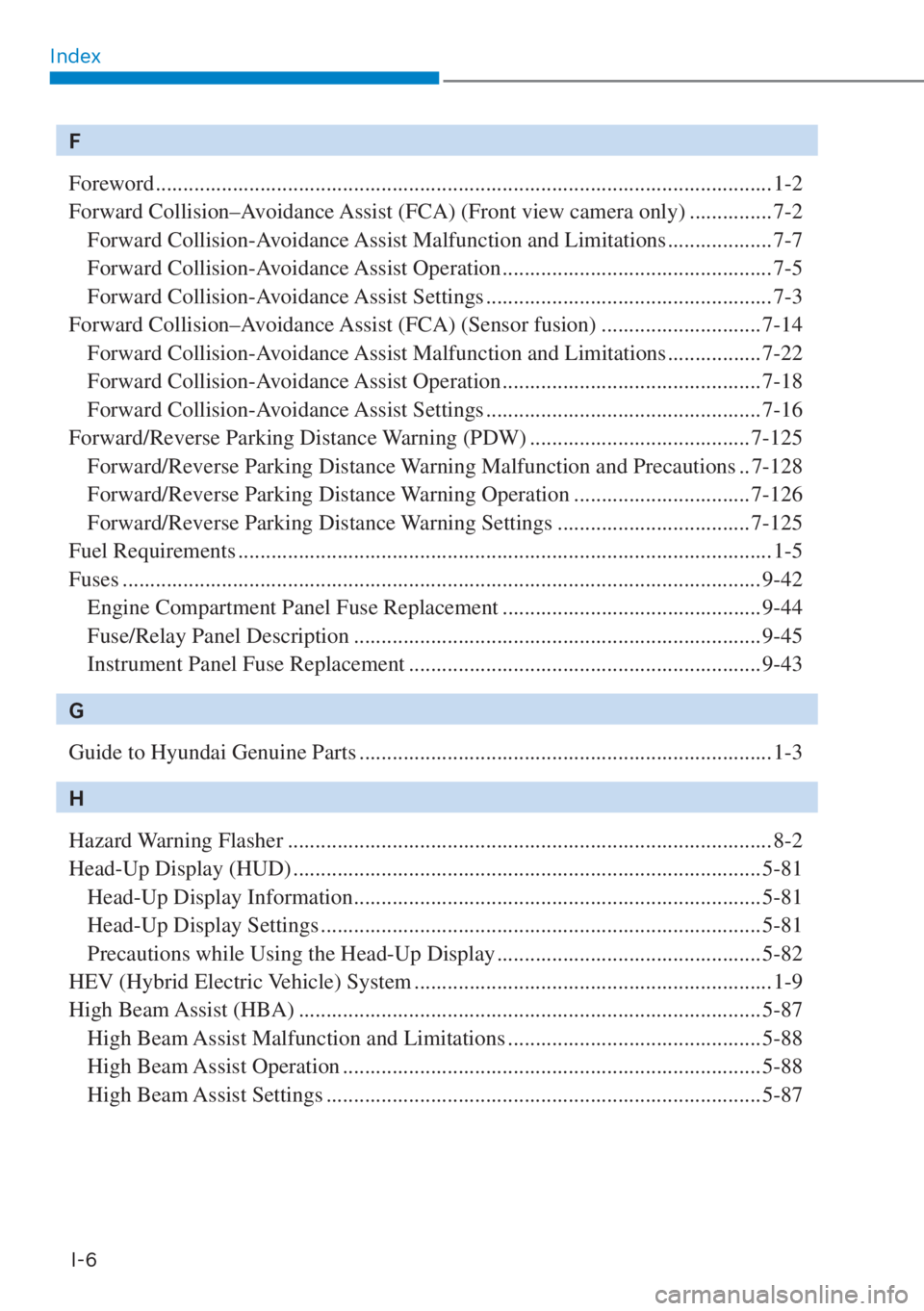
IndexI-6
F
Foreword ...............................................................\
................................................. 1-2
Forward Collision–Avoidance Assist (FCA) (Front view camera only) ............... 7-2
Forward Collision-Avoidance Assist Malfunction and Limitations ................... 7-7
Forward Collision-Avoidance Assist Operation ................................................. 7-5
Forward Collision-Avoidance Assist Settings .................................................... 7-3
Forward Collision–Avoidance Assist (FCA) (Sensor fusion) ............................. 7-14
Forward Collision-Avoidance Assist Malfunction and Limitations ................. 7-22
Forward Collision-Avoidance Assist Operation ............................................... 7-18
Forward Collision-Avoidance Assist Settings .................................................. 7-16
Forward/Reverse Parking Distance Warning (PDW) ........................................ 7-125
Forward/Reverse Parking Distance Warning Malfunction and Precautions .. 7-128
Forward/Reverse Parking Distance Warning Operation ................................ 7-126
Forward/Reverse Parking Distance Warning Settings ................................... 7-125
Fuel Requirements ........................................................................\
......................... 1-5
Fuses ..................................................................\
.................................................. 9-42
Engine Compartment Panel Fuse Replacement ............................................... 9-44
Fuse/Relay Panel Description ........................................................................\
.. 9-45
Instrument Panel Fuse Replacement ................................................................ 9-43
G
Guide to Hyundai Genuine Parts ........................................................................\
... 1-3
H
Hazard Warning Flasher ........................................................................\
................ 8-2
Head-Up Display (HUD) ........................................................................\
............. 5-81
Head-Up Display Information ........................................................................\
.. 5-81
Head-Up Display Settings ........................................................................\
........ 5-81
Precautions while Using the Head-Up Display ................................................ 5-82
HEV (Hybrid Electric Vehicle) System ................................................................. 1-9
High Beam Assist (HBA) ........................................................................\
............ 5-87
High Beam Assist Malfunction and Limitations .............................................. 5-88
High Beam Assist Operation ........................................................................\
.... 5-88
High Beam Assist Settings ........................................................................\
....... 5-87